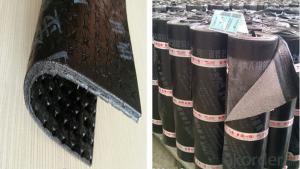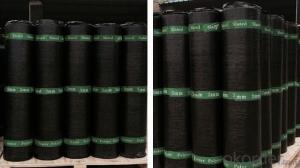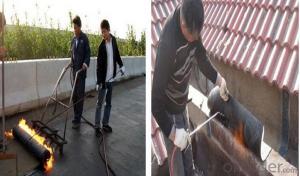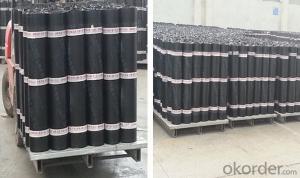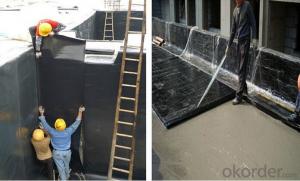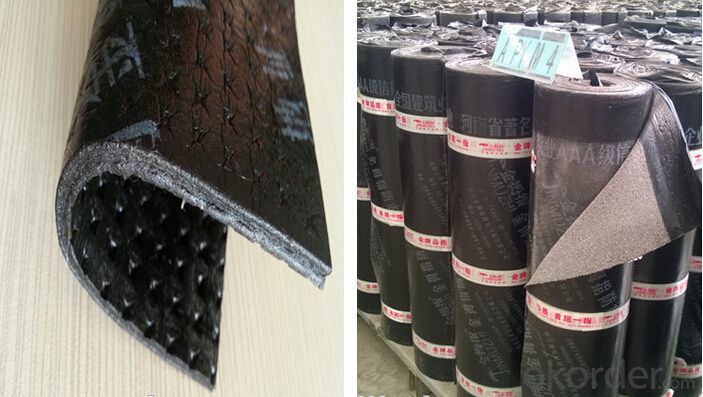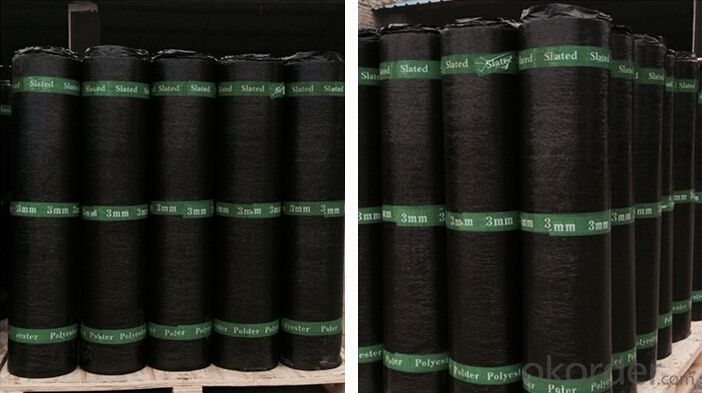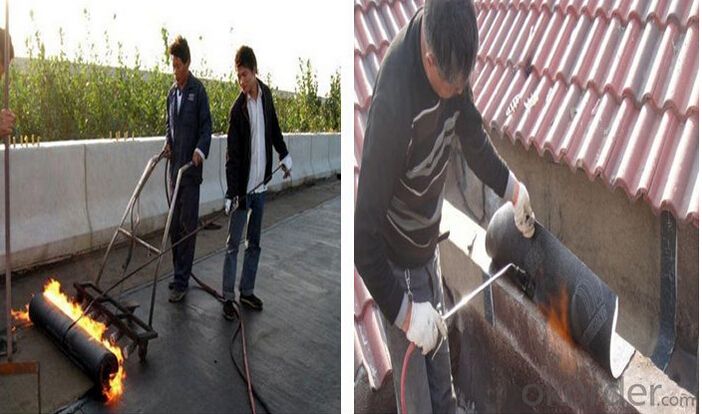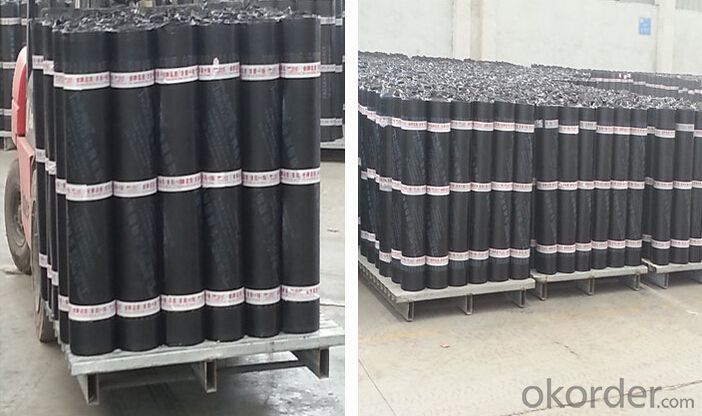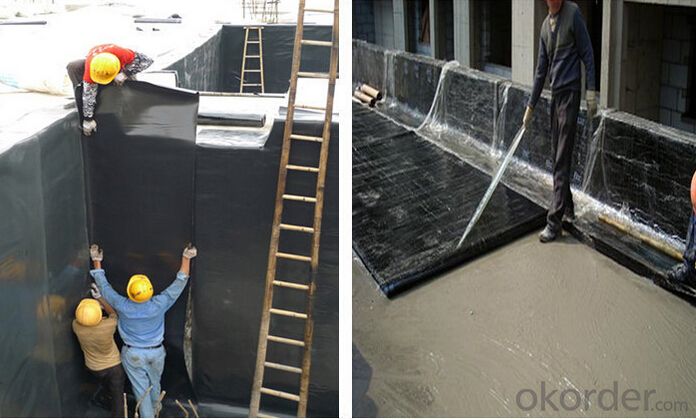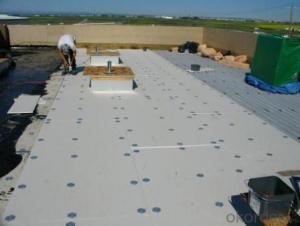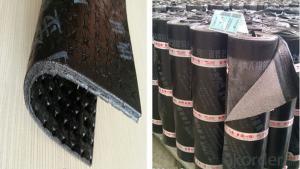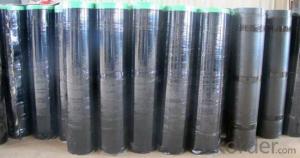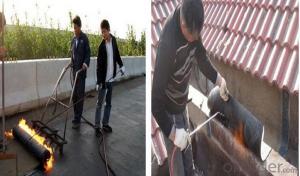SBS Modified Bituminous Waterproofing Membrane For Roofing
- Loading Port:
- Shanghai
- Payment Terms:
- TT OR LC
- Min Order Qty:
- 1000 m²
- Supply Capability:
- 200000 m²/month
OKorder Service Pledge
OKorder Financial Service
You Might Also Like
product description:
sbs waterproof membrane take the “Skin” type waterproof thought, according to the features of construction site, on the basis of width elastomeric modified bitumen waterproofing membrane, combining with features of wet-application self-adhesive membrane, use advanced equipment to produce 2 meters width that WP-SBS wet-application width elastomeric modified bitumen waterproofing membrane (Hereinafter referred to: WP-SBS membrane).WP-SBS is made of bitumen modified with Styrene-Butadiene- Styrene (SBS)as dipping and painting. Its upper surface covers PE membrane and color sand or schist, and lower surface is made of isolation material. Products correspond to the national standards GB18242-2008(elastomeric modified bitumen waterproofing membrane), paste by cement or cement mortar, and construct on the wet base, achieving tight and full adhesion with substrates, eliminating fluid-channeling layer, all above contribute to making a reliable “Skin” type waterproof system, which is a breakthrough innovation in ordinary modified bitumen membrane.
Characteristic
1.Good impermeability
2.Possess good tensile strength, elongation and size stability which could be well suited the substrate distortion and crack.
3.Good performance in anti-strength, anti-resistance , anti-erosion, anti-mildew, anti-weathering
4.SBS modified bitumen membrane is specially being applied in the cold area with low temperature, while APP modified bitumen membrane is applied in the area with high temperature.
5.Convenient installation
Applicable scope:
It is widely used for civil building roofing, underground, bridge, parking, pool, tunnel in the line of waterproofing and dampproofing, especially for the building under high temperature.
Application method:
1.Make sure the roof deck smooth ,clean and dry(Moisture<9%),then apply the surface of roof deck homogeneously with a kind bitumen paint till dry to start application.
2.There are two methods in application:
One way is by heating and melting method---Heat the polyethylene film of the membrane and roof deck surface by heating and melting method to be nearly melted (not flowing),then install the membrane fully bonded to the roof deck with overlaps of 5-10cm.
The other way is by cold adhesive method---Pour the cold adhesive homogeneously on the roof deck then roll the membrane to install it to be fully sticked to roof deck.
By heating and melting method and by cold adhesive can be used in alternation in application as requested.
3.After application ,a full serious inspection is required to make sure no air bubble ,no fold,no falling away etc to guarantee the waterproof life.
Our Services
1.If you need some advises for the waterproof construction, we have the best engineer to serve you.
2.We send the free samples to you by freight collect.
3.We will guarantee the quality and the competitive price.
4.We will give you the best packaging and safe shipping.
5.If any problem, we will always be right here waiting for you.
Packaging & Shipping
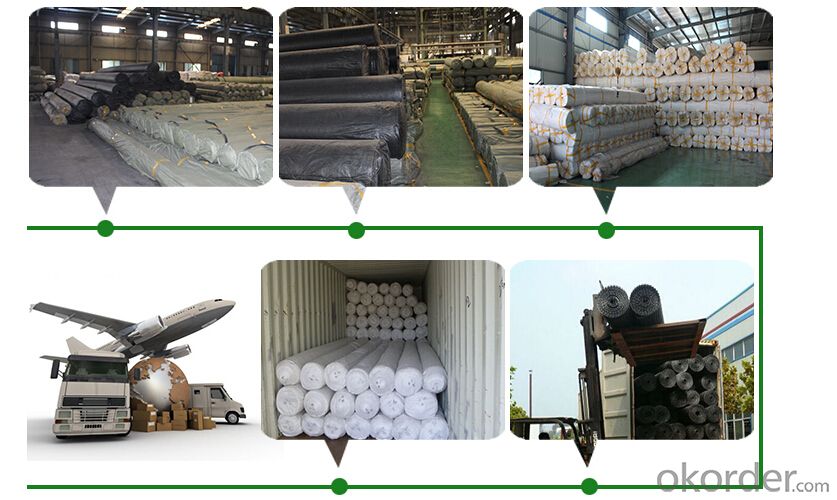
| Packing | Woven bag/PE bag packing or as customer request |
| Shipping | FOB Changsha,customized shipping terms and oppointed port accepted |
Technical parameter
| Item | Specifications | ||||||||
| Geotextile Unit Weight (g/m²) | 300 | 500 | 600 | 700 | 800 | 900 | 1000 | 1100 | |
| Geomembrane Thickness (mm) | 0.25-0.35 | 0.30-0.50 | |||||||
| Nominal Fracture Strength (KN/m) | 2.50 | 7.50 | 10 | 12 | 14 | 16 | 18 | 20 | |
| Breaking Strength (KN/m,≥,LD/TD) | 2.50 | 7.50 | 10 | 12 | 14 | 16 | 18 | 20 | |
| Standard Intensity Corresponding Elongation Rate (%) | 30~100 | ||||||||
| CBR Burst Strength (KN,≥) | 0.70 | 1.50 | 1.90 | 2.20 | 2.50 | 2.80 | 3.00 | 3.20 | |
| Longitudinal Tear Strength (KN,≥) | 0.05 | 0.25 | 0.32 | 0.40 | 0.48 | 0.56 | 0.62 | 0.70 | |
| Hydrostatic Pressve (Mpa) | See List Below | ||||||||
| Peel Strength (N/cm,≥) | 6 | ||||||||
| Vertical Permeability Coefficient (cm/s) | According to design or contract mentioned. | ||||||||
| Width Variation (%) | -1.00 | ||||||||
| Item | Geomembrane Thickness (mm) | ||||||||
| 0.20 | 0.30 | 0.40 | 0.50 | 0.60 | 0.70 | 0.80 | 1.00 | ||
| Hydrostatic Pressve (Mpa) | One geotextiles with one geomembrane | 0.40 | 0.50 | 0.60 | 0.80 | 1.00 | 1.20 | 1.40 | 1.60 |
| Two geotextiles with one geomembrane | 0.50 | 0.60 | 0.80 | 1.00 | 1.20 | 1.40 | 1.60 | 1.80 | |
Professional test machines ensure the products qualified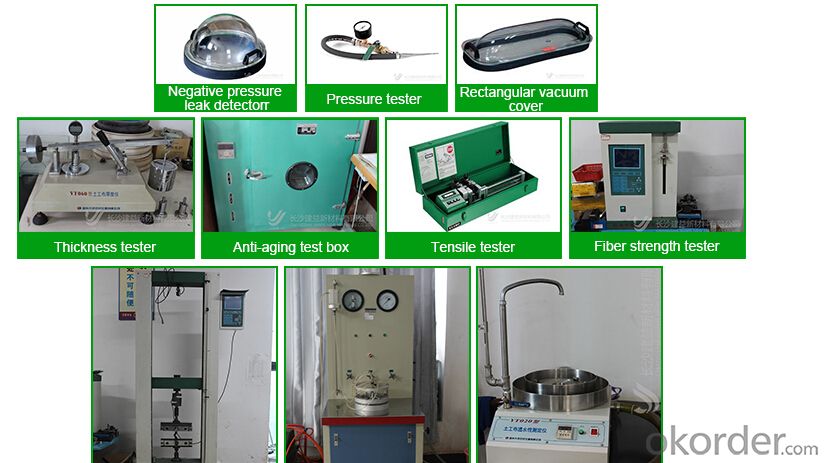 roduct certifications
roduct certifications
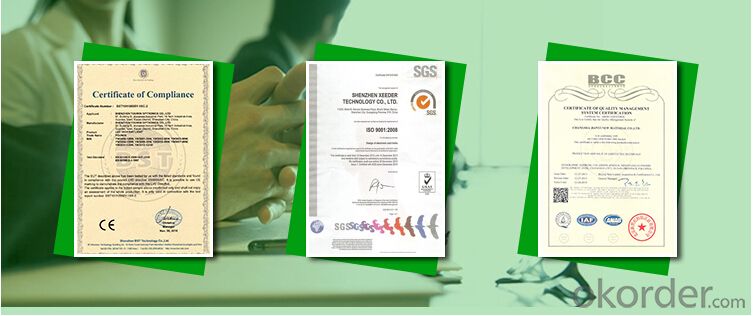
Inquiry Note
How to send an effective inquiry for saving your time?
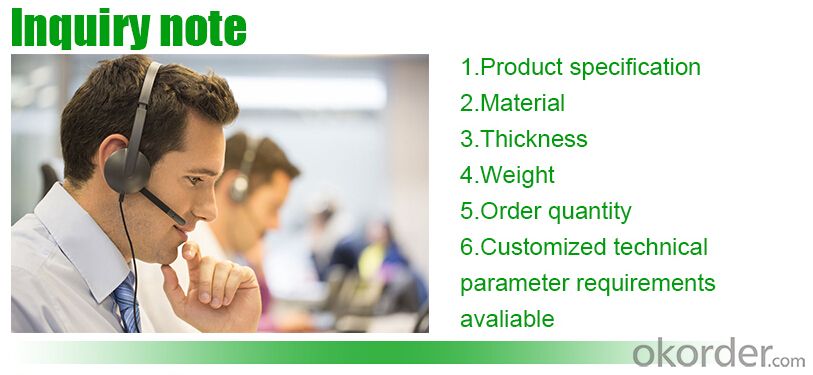
product show
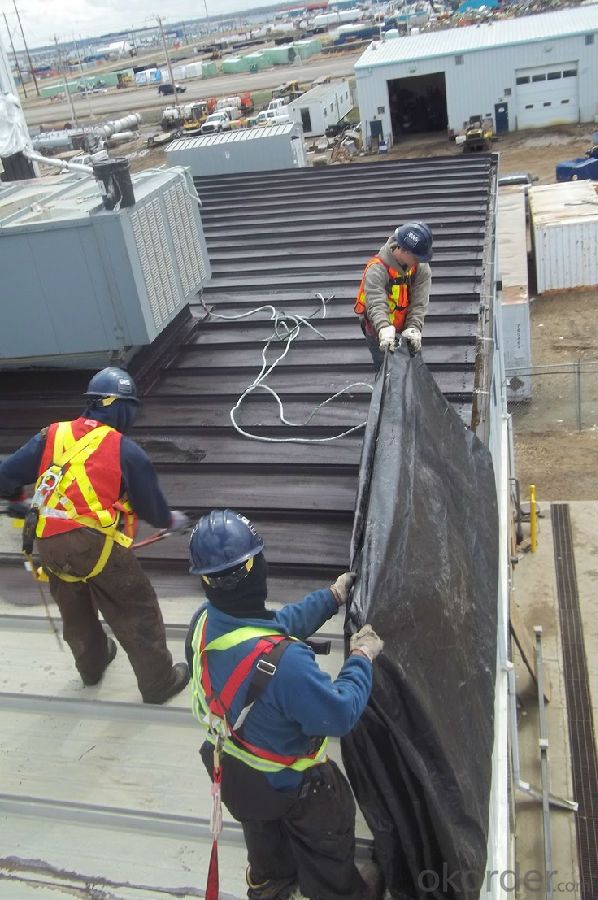
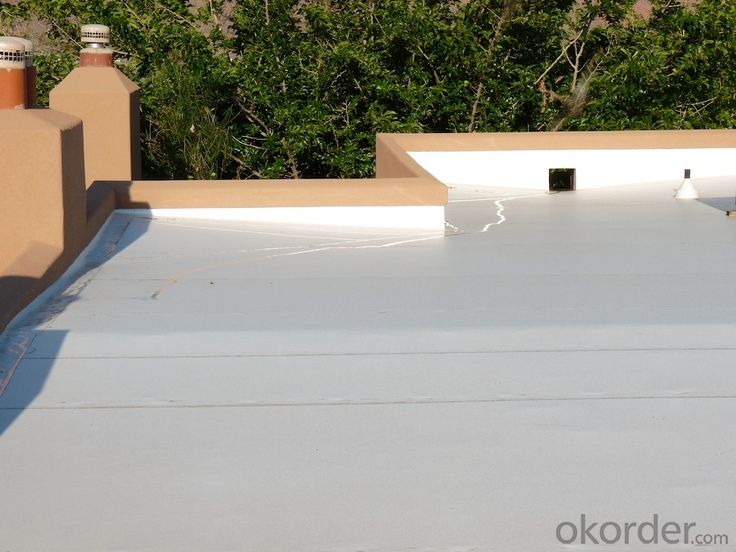
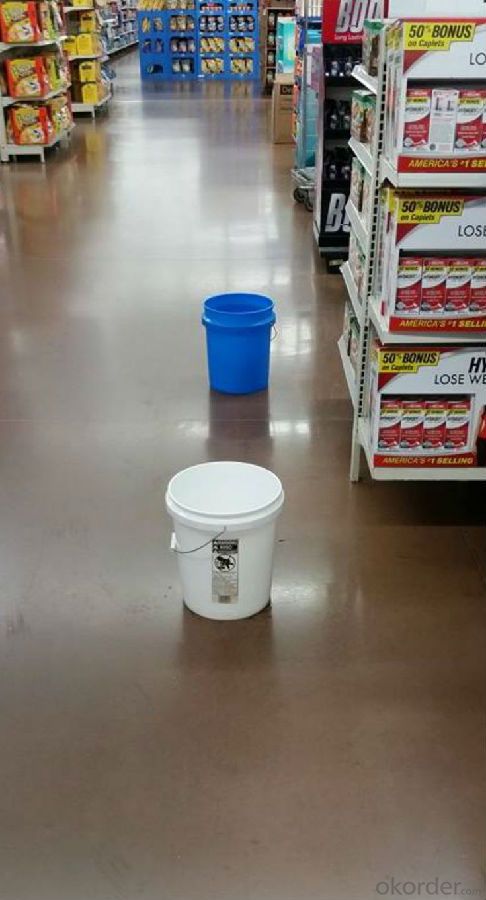
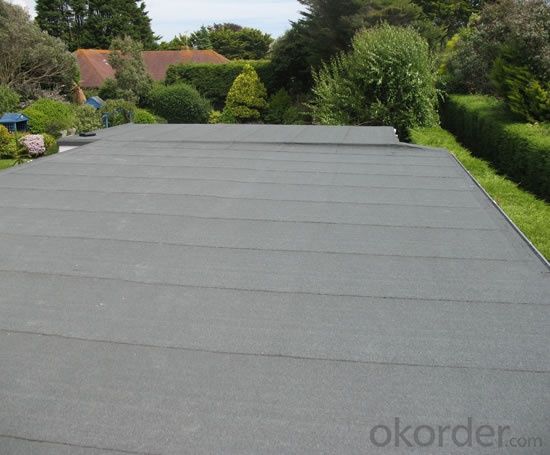
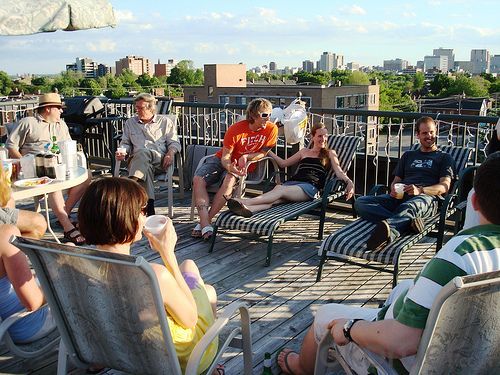
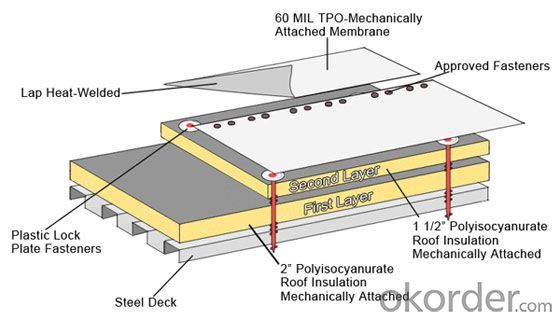
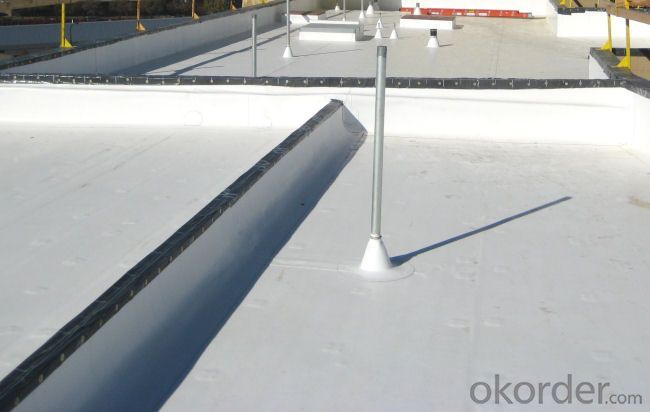
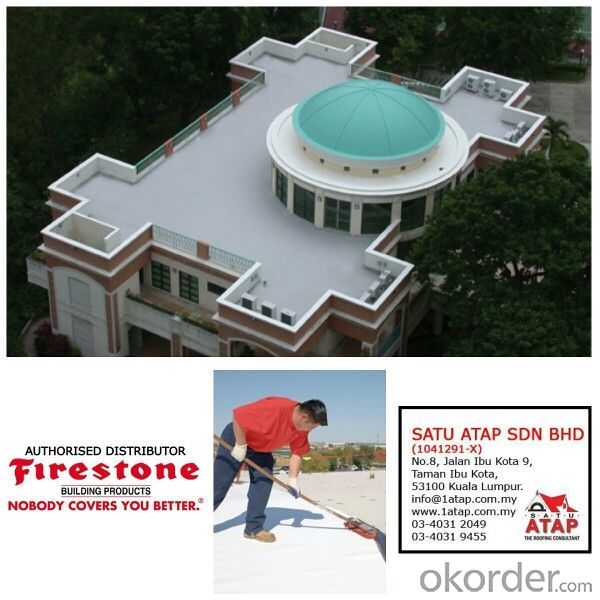
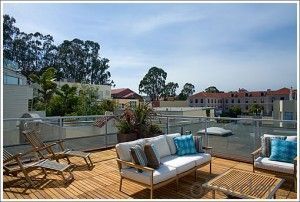
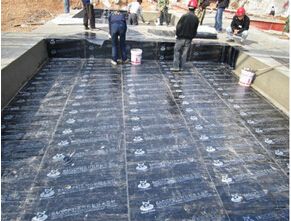
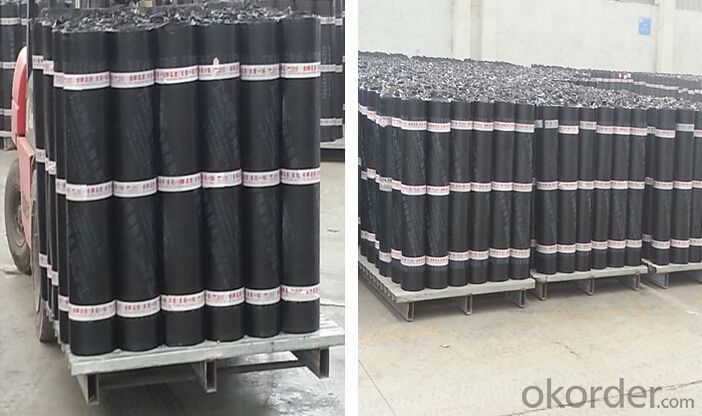
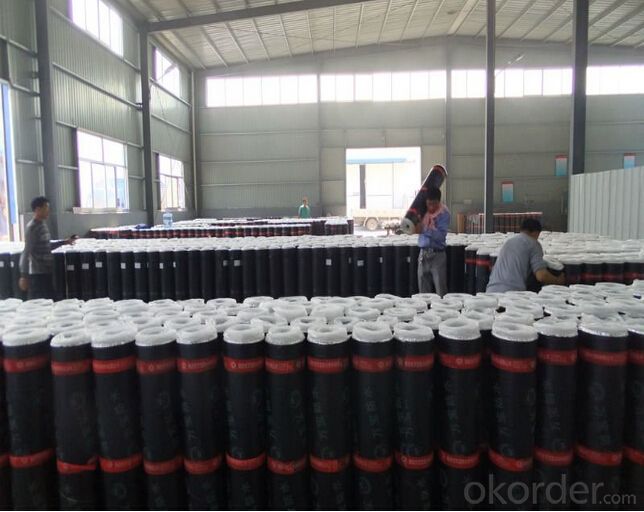
FAQ

- Q: Is a waterproofing membrane resistant to mold and mildew growth?
- Indeed, the resistance of a waterproofing membrane to the growth of mold and mildew stems from its specific design, which aims to establish a barrier against moisture infiltration. This impedes water seepage and the subsequent development of mold and mildew. Through the effective sealing of the area, these membranes eradicate the favorable conditions for the proliferation of mold and mildew, such as dampness and moisture. However, it is important to acknowledge that although the membrane itself exhibits resistance to mold and mildew growth, it does not guarantee absolute protection against these issues. Proper installation, regular maintenance, and ensuring adequate ventilation play pivotal roles in preventing the long-term growth of mold and mildew.
- Q: Does a waterproofing membrane affect the appearance or finish of a surface?
- Yes, a waterproofing membrane can affect the appearance or finish of a surface. When applied, the membrane forms a barrier that prevents water or moisture from penetrating the surface. Depending on the type of membrane used, it can create a visible layer on top of the surface, altering its appearance. For example, a clear liquid membrane may leave a glossy finish, while a sheet membrane may create a textured or patterned surface. Additionally, some membranes may change the color or darken the surface slightly. Therefore, it is important to consider the aesthetic implications of a waterproofing membrane before application, especially if maintaining the original appearance of the surface is a priority.
- Q: Can waterproofing membranes be applied on roofs?
- Yes, waterproofing membranes can be applied on roofs. In fact, they are commonly used in the construction industry to provide an extra layer of protection against water infiltration. These membranes are typically made of synthetic materials such as PVC, TPO, or EPDM, which are highly resistant to water and can effectively prevent leaks and water damage on roofs. The application of waterproofing membranes on roofs is a proven method to enhance the longevity and durability of the roofing system, especially in areas prone to heavy rainfall or extreme weather conditions. Additionally, waterproofing membranes are flexible and can be easily installed on various types of roofing materials, including concrete, metal, or asphalt shingles. Therefore, if you want to ensure a watertight roof and protect your property from water-related issues, using waterproofing membranes is a reliable and effective solution.
- Q: Can a waterproofing membrane be used on zinc surfaces?
- Yes, a waterproofing membrane can be used on zinc surfaces. Zinc is a durable and corrosion-resistant material, and a waterproofing membrane can provide an additional layer of protection against water infiltration, ensuring the longevity and integrity of the zinc surface.
- Q: Can a waterproofing membrane be applied to concrete?
- Yes, a waterproofing membrane can be applied to concrete. In fact, it is a common and effective method used to protect concrete structures from water damage. The membrane is typically made of a flexible material, such as rubber or polymer, that is applied to the surface of the concrete. This creates a barrier that prevents water from penetrating the concrete and causing deterioration or structural damage. Waterproofing membranes can be applied to various types of concrete structures, including basements, foundations, roofs, and balconies. The application process typically involves cleaning and preparing the concrete surface, applying a primer if necessary, and then applying the membrane using a brush, roller, or spray. It is important to follow the manufacturer's instructions and ensure proper installation to achieve the desired level of waterproofing.
- Q: SBS modified asphalt waterproofing membrane and synthetic polymer membrane the same, not the same, what is the difference?
- SBS modified asphalt waterproofing membrane is a kind of high-polymer modified asphalt waterproofing membrane, high polymer modified asphalt waterproofing membrane is synthetic polymer modified asphalt coating layer,
- Q: What is the cost of a waterproofing membrane?
- There are several factors that can cause the cost of a waterproofing membrane to vary, including the type of membrane, the size of the area that needs to be covered, and how complex the installation is. Generally, the cost for materials alone ranges from $1 to $4 per square foot. However, it is crucial to keep in mind that there may be additional expenses for labor, equipment, or any repairs or preparation work that may be needed. Consequently, it is advised to seek quotes from reliable contractors or suppliers in order to obtain an accurate estimate for your particular project.
- Q: Can a waterproofing membrane be used on brick walls?
- Yes, a waterproofing membrane can be used on brick walls. Brick is a porous material that can absorb water and moisture, making it susceptible to damage and deterioration over time. Applying a waterproofing membrane on brick walls helps to prevent water penetration and protect the structural integrity of the bricks. The membrane acts as a barrier, preventing water from seeping into the bricks while still allowing moisture to evaporate. This helps to keep the bricks dry and reduces the risk of water-related issues such as efflorescence, mold, and mildew. Additionally, a waterproofing membrane can also enhance the thermal insulation properties of the brick walls by reducing heat loss and improving energy efficiency. It is important to choose a waterproofing membrane specifically designed for use on masonry surfaces to ensure proper adhesion and long-lasting protection.
- Q: Does a waterproofing membrane require any curing time before it can be exposed to water?
- Before being exposed to water, a waterproofing membrane does require a curing time. This curing time is necessary for the membrane to fully bond and reach its maximum strength, durability, and waterproofing capabilities. The specific duration of the curing time may vary depending on the type of membrane and the instructions provided by the manufacturer. To ensure proper curing and effective protection against water intrusion, it is crucial to adhere to these instructions. Neglecting to allow sufficient curing time can compromise the membrane's effectiveness, potentially resulting in leaks or other related issues. Therefore, it is highly recommended to wait until the specified curing time has passed before exposing the waterproofing membrane to water.
- Q: How does a waterproofing membrane handle movement or settling of the structure?
- A waterproofing membrane is designed to be flexible and accommodate the movement or settling of a structure. It can stretch or contract as the building expands or contracts, ensuring that it remains intact and maintains its waterproofing properties. This flexibility helps to prevent any cracks or gaps from forming in the membrane, which could otherwise lead to water leakage.
Send your message to us
SBS Modified Bituminous Waterproofing Membrane For Roofing
- Loading Port:
- Shanghai
- Payment Terms:
- TT OR LC
- Min Order Qty:
- 1000 m²
- Supply Capability:
- 200000 m²/month
OKorder Service Pledge
OKorder Financial Service
Similar products
Hot products
Hot Searches
Related keywords
